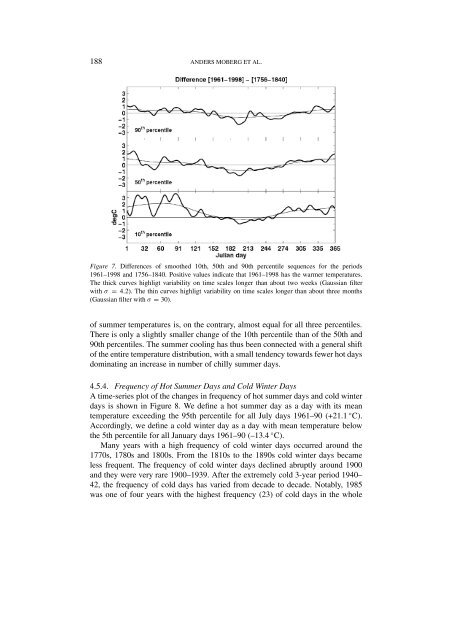DAILY AIR TEMPERATURE AND PRESSURE SERIES ... - BALTEX
DAILY AIR TEMPERATURE AND PRESSURE SERIES ... - BALTEX
DAILY AIR TEMPERATURE AND PRESSURE SERIES ... - BALTEX
You also want an ePaper? Increase the reach of your titles
YUMPU automatically turns print PDFs into web optimized ePapers that Google loves.
188 <strong>AND</strong>ERS MOBERG ET AL.<br />
Figure 7. Differences of smoothed 10th, 50th and 90th percentile sequences for the periods<br />
1961–1998 and 1756–1840. Positive values indicate that 1961–1998 has the warmer temperatures.<br />
The thick curves highligt variability on time scales longer than about two weeks (Gaussian filter<br />
with σ = 4.2). The thin curves highligt variability on time scales longer than about three months<br />
(Gaussian filter with σ = 30).<br />
of summer temperatures is, on the contrary, almost equal for all three percentiles.<br />
There is only a slightly smaller change of the 10th percentile than of the 50th and<br />
90th percentiles. The summer cooling has thus been connected with a general shift<br />
of the entire temperature distribution, with a small tendency towards fewer hot days<br />
dominating an increase in number of chilly summer days.<br />
4.5.4. Frequency of Hot Summer Days and Cold Winter Days<br />
A time-series plot of the changes in frequency of hot summer days and cold winter<br />
days is shown in Figure 8. We define a hot summer day as a day with its mean<br />
temperature exceeding the 95th percentile for all July days 1961–90 (+21.1 ◦ C).<br />
Accordingly, we define a cold winter day as a day with mean temperature below<br />
the 5th percentile for all January days 1961–90 (–13.4 ◦ C).<br />
Many years with a high frequency of cold winter days occurred around the<br />
1770s, 1780s and 1800s. From the 1810s to the 1890s cold winter days became<br />
less frequent. The frequency of cold winter days declined abruptly around 1900<br />
and they were very rare 1900–1939. After the extremely cold 3-year period 1940–<br />
42, the frequency of cold days has varied from decade to decade. Notably, 1985<br />
was one of four years with the highest frequency (23) of cold days in the whole













